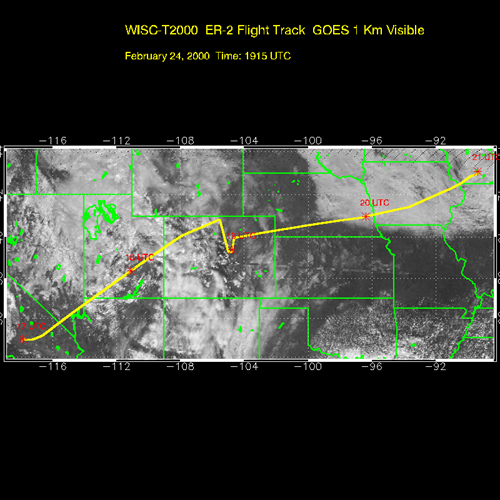WISC-T2000: Wisconsin Snow Cloud – Terra 2000 experiment (WISC-T2000)
The Wisconsin Snow and Cloud – Terra 2000 (WISC-T2000) experiment is being conducted from February 25 to March 13, 2000 to validate science products from instruments on NASA’s Earth Observing System (EOS) Terra satellite. The recently launched (Dec. 1999) Terra satellite is the first of two (the second, called Aqua, is scheduled for launch in Dec. 2000) EOS satellites designed to measure earth surface and atmospheric characteristics over the global domain. Expected science products include global cloud cover and cloud type, atmospheric temperature and moisture, surface reflectance, and sea surface temperature among many others. These measurements will lead to further understanding of the earth’s radiation budget and global climate change. WISC-T2000 focuses on two of the five Terra instruments, the MODerate resolution Imaging Spectroradiometer (MODIS) and the Multiangle Imaging SpectroRadiometer (MISR). During the experiment a NASA ER-2 aircraft will be based in Madison, WI and will carry carefully calibrated instrumentation designed to simulate MODIS and MISR measurements from Terra. The ER-2 will be used to map surface and atmospheric properties while Terra is overhead. The ER-2 instrumentation includes the MODIS Airborne Simulator (MAS), the Scanning High-resolution Interferometer Sounder (S-HIS), the Cloud Lidar System (CLS), the Air Multi-angle Imaging SpectroRadiometer (AirMISR), and two camera systems. The MAS data will provide 50 m resolution images of the earth in solar and thermal bands for mapping high resolution spatial variation. The S-HIS will be used to measure the vertical atmospheric profile, producing soundings much like weather balloons. CLS will be used to map the vertical profile of clouds and aerosols beneath the ER-2. AirMISR will make multi-angle measurements of earth reflectance to assess the angular distribution of solar reflection.
WISC-T2000, the first in a series of Terra science product validation experiments, is a combined effort of NASA’s Dryden Flight Research Center (DFRC), the University of Wisconsin’s Space Science and Engineering Center (SSEC), NASA’s Jet Propulsion Laboratory (JPL), the University of Colorado and NASA’s Goddard Space Flight Center (GSFC). The ER-2 instrumentation has been developed and maintained at SSEC, JPL, GSFC, and NASA’s Ames Research Center.
Cooperative Institute for Meteorological Satellite Studies (CIMSS), University of Wisconsin-Madison
Investigators
- Christopher Moeller Cooperative Institute for Meteorological Satellite Studies (CIMSS)


